
Body weight leg exercises for beginners are a fantastic way to kickstart your fitness journey. In this article, we'll explore different exercises and variations that target your legs using just your body weight. From Bulgarian split squats to glute bridge marches, we'll guide you through proper form and provide modifications for beginners. Additionally, we'll discuss the importance of creating a balanced workout routine and share tips for success and safety. Let's get started on building strong, toned legs!
🔍 Seeking a breakthrough in Type 2 Diabetes management?
Discover our expert insights and innovative approaches on ‘How to Cure Diabetes’.
Click to transform your health journey today!

What you\'ll find in this article?
- Bulgarian Split Squat - Body Weight Leg Exercises for Beginners: Start Now!
- Glute Bridge March - Body Weight Leg Exercises for Beginners: Start Now!
- Other Body Weight Leg Exercises - Body Weight Leg Exercises for Beginners: Start Now!
- Creating an Effective Body Weight Leg Workout Routine - Body Weight Leg Exercises for Beginners: Start Now!
- Tips for Success and Safety - Body Weight Leg Exercises for Beginners: Start Now!
Bulgarian Split Squat - Body Weight Leg Exercises for Beginners: Start Now!
How to Perform the Bulgarian Split Squat
The Bulgarian Split Squat is an effective body weight leg exercise that targets the quads, glutes, and hamstrings. Follow the steps below to perform this exercise with proper form:
- Start by standing in a split stance, with one foot a few feet in front of the other.
- Place the back foot on a stable elevated surface, such as a bench or step.
- Lower your body down by bending the front knee, keeping the back knee off the ground.
- Descend until the front thigh is parallel to the ground, ensuring that your knee stays directly above your ankle.
- Push through the front heel to extend the knee and return to the starting position.
- Repeat for the desired number of repetitions and then switch legs.
Explore our specialized services in diabetes care 🌟.
From personalized diet plans to effective exercise routines, we have what you need to take control of Type 2 Diabetes.
Visit our services page now!

Common Mistakes to Avoid
To get the most out of your Bulgarian Split Squat and prevent injury, be aware of these common mistakes:
- Avoid leaning too far forward while performing the exercise. Keep your torso upright and engage your core.
- Ensure that your front knee does not collapse inward; it should be aligned with your toes.
- Do not let your front knee extend too far beyond your toes, as this can place excessive stress on the knee joint.
- Keep your back straight and avoid rounding your shoulders.
Variations and Progressions for Different Fitness Levels
Once you have mastered the basic Bulgarian Split Squat, you can try these variations to further challenge yourself:
- Hold dumbbells or kettlebells in your hands for added resistance
- Elevate the front foot on a step or platform to increase the range of motion
- Perform the exercise while holding onto a stability ball or TRX straps for balance and stabilization
Remember to start with proper form and gradually increase the intensity as your strength and stability improve.

Glute Bridge March - Body Weight Leg Exercises for Beginners: Start Now!
The Glute Bridge March is an effective body weight leg exercise that targets the glutes, hamstrings, and core muscles. It is a beginner-friendly exercise that can be performed anywhere, without the need for any equipment. Let's dive into the step-by-step guide, targeted muscles and benefits, as well as modifications and tips for beginners.
Step-by-Step Guide for Glute Bridge March
1. Lie flat on your back with your knees bent and feet flat on the ground, hip-width apart.
2. Engage your core and squeeze your glutes as you lift your hips off the ground until your body forms a straight line from your knees to shoulders.
3. While maintaining this bridge position, lift one foot off the ground and bring your knee towards your chest.
4. Lower your foot back to the ground and repeat the same movement with the other foot.
5. Continue alternating the march for the desired number of repetitions.
Targeted Muscles and Benefits
The Glute Bridge March primarily targets the glutes, hamstrings, and core muscles. By engaging these muscles, it helps improve lower body strength, stability, and posture. Additionally, this exercise can help activate and strengthen the gluteal muscles, which are often underutilized due to long periods of sitting or inactivity.
Modifications and Tips for Beginners
- If you find it challenging to maintain proper form, start by performing the exercise with both feet on the ground without incorporating the marching motion. This will allow you to focus on mastering the bridge position.
- Gradually increase the intensity by lifting your knees higher during the march or by holding the bridge position for a longer duration.
- To add variation, you can place a resistance band above your knees, providing additional resistance and targeting the outer thigh muscles.
- Remember to breathe throughout the exercise and avoid holding your breath.
- If you experience any discomfort or pain, it is essential to consult with a healthcare professional before continuing with this exercise.
With the Glute Bridge March, you can effectively strengthen your lower body muscles and improve your overall fitness level. Incorporate this exercise into your body weight leg workout routine for optimal results.
Other Body Weight Leg Exercises - Body Weight Leg Exercises for Beginners: Start Now!
Squats: A Fundamental Leg Exercise
Squats are a foundational leg exercise that targets multiple muscle groups, including the quadriceps, hamstrings, and glutes. To perform squats correctly, begin by standing with your feet shoulder-width apart. Bend your knees and lower your body as if you were sitting back into a chair. Keep your chest lifted and your core engaged throughout the movement. Push through your heels to stand back up. Squats can be modified by using a chair for support or by adding a jump at the end for an extra challenge.
Step-Up: Strengthening the Lower Body
The step-up exercise is an effective way to target the muscles in your lower body, including your quads, hamstrings, and glutes. To perform a step-up, find a stable bench or step. Step one foot onto the elevated surface and press through your heel to lift your body up. Bring your other foot up and step back down with control. Repeat on the other side. You can make this exercise more challenging by holding weights or increasing the height of the step.
Lunges: Enhancing Muscle Stability and Balance
Lunges are excellent for building lower body strength, stability, and improving balance. Start by standing with your feet hip-width apart. Take a big step forward with one foot and lower your body until both knees are at a 90-degree angle. Keep your front knee aligned with your ankle and your back knee hovering above the ground. Push through your front heel to return to the starting position, then repeat with the other leg. Lunges can be modified by using a chair for support or by holding weights to increase the intensity.
These exercises provide a well-rounded workout for your legs, targeting different muscle groups and improving overall lower body strength and stability. By incorporating squats, step-ups, and lunges into your routine, you can achieve balanced muscle development and enhance your fitness journey.
Creating an Effective Body Weight Leg Workout Routine - Body Weight Leg Exercises for Beginners: Start Now!

Selecting Exercises for a Balanced Workout
To create an effective body weight leg workout routine, it is important to select a variety of exercises that target different muscle groups in the legs. This ensures a balanced workout that engages all the major leg muscles, including the quadriceps, hamstrings, glutes, and calves.
- Include exercises such as Bulgarian Split Squats, Glute Bridge March, Squats, Step-Up, and Lunges.
- These exercises target different muscles and help to develop strength, stability, and flexibility in the legs.
- Choose exercises that suit your fitness level and gradually increase the intensity as you progress.
Repetitions and Sets for Optimal Strength and Endurance
When performing body weight leg exercises, it is essential to determine the right number of repetitions and sets to maximize your strength and endurance gains.
- Beginners can start with 10-12 repetitions for each exercise and aim for 2-3 sets.
- As you become more experienced, gradually increase the number of repetitions and sets to challenge yourself.
- Listen to your body and adjust the repetitions and sets accordingly, ensuring that you maintain proper form throughout.
Integrating Leg Exercises into Full-Body Workouts
In addition to focusing on leg exercises, it is crucial to integrate them into full-body workouts to achieve overall fitness and avoid muscle imbalances. Here are some tips to incorporate leg exercises effectively:
- Combine leg exercises with upper body and core exercises for a complete workout.
- Alternate between different exercises to target different muscle groups and prevent overuse injuries.
- Include a variety of exercises that challenge your legs in different ways, such as targeting strength, endurance, and stability.
- Ensure that you have recovery days in your workout routine to allow your muscles to repair and grow stronger.
Tips for Success and Safety - Body Weight Leg Exercises for Beginners: Start Now!
When it comes to achieving optimal results and staying safe during your body weight leg exercises for beginners, there are certain tips you should keep in mind. These tips will help you maximize the effectiveness of your workouts while minimizing the risk of injuries.
Importance of Warm-up and Cool-down
Before diving into your leg workout routine, it's crucial to warm up your muscles and prepare your body for the upcoming physical activity. A proper warm-up increases blood flow, raises body temperature, and loosens up the muscles, reducing the risk of strains and tears. Spend at least 5-10 minutes performing dynamic stretches and light cardio exercises like jogging or jumping jacks.
Similarly, a cool-down after your leg workouts helps your body gradually return to its resting state and prevents muscles from becoming stiff or sore. Focus on static stretches that target the muscles you just worked, holding each stretch for 20-30 seconds.
Listening to Your Body and Adjusting Intensity
It's essential to listen to your body during your body weight leg exercises. Pay attention to any discomfort or pain and adjust the intensity or modify the exercise accordingly. Pushing beyond your limits may lead to injuries and setbacks, so always prioritize your safety.
Start with exercises that match your current fitness level, gradually increasing the intensity and difficulty as you gain strength and confidence. Proper form is also crucial – prioritize quality over quantity. If an exercise feels too challenging or causes pain, regress or modify the movement to make it more accessible.
Recovery and Rest Days for Optimal Results
While it's tempting to go all-out and exercise every day, rest and recovery days are just as important for obtaining optimal results. During rest days, your muscles repair and rebuild, leading to overall strength and endurance gains. Aim for at least one to two rest days per week.
Additionally, incorporating other forms of exercise into your routine, such as stretching, yoga, or low-impact cardio, can help improve flexibility, balance, and overall physical well-being. Cross-training allows your leg muscles to recover from the stress of body weight exercises while still engaging in physical activity.
By following these tips for success and safety, you'll be well on your way to achieving your fitness goals and maintaining a healthy, injury-free body weight leg exercise routine.
✨ Other articles you might be interested in:
- Understanding why exercise sometimes raises blood glucose levels
- Maximizing Blood Sugar Levels and Exercise for Diabetes Management
- Rowing Before and After: Transform Your Fitness with Our Tips!
- Aqua Zumba and Diabetes Management: Forum Discussions on Benefits and Tips
- Type 1: Everest base camp essentials for trekkers



